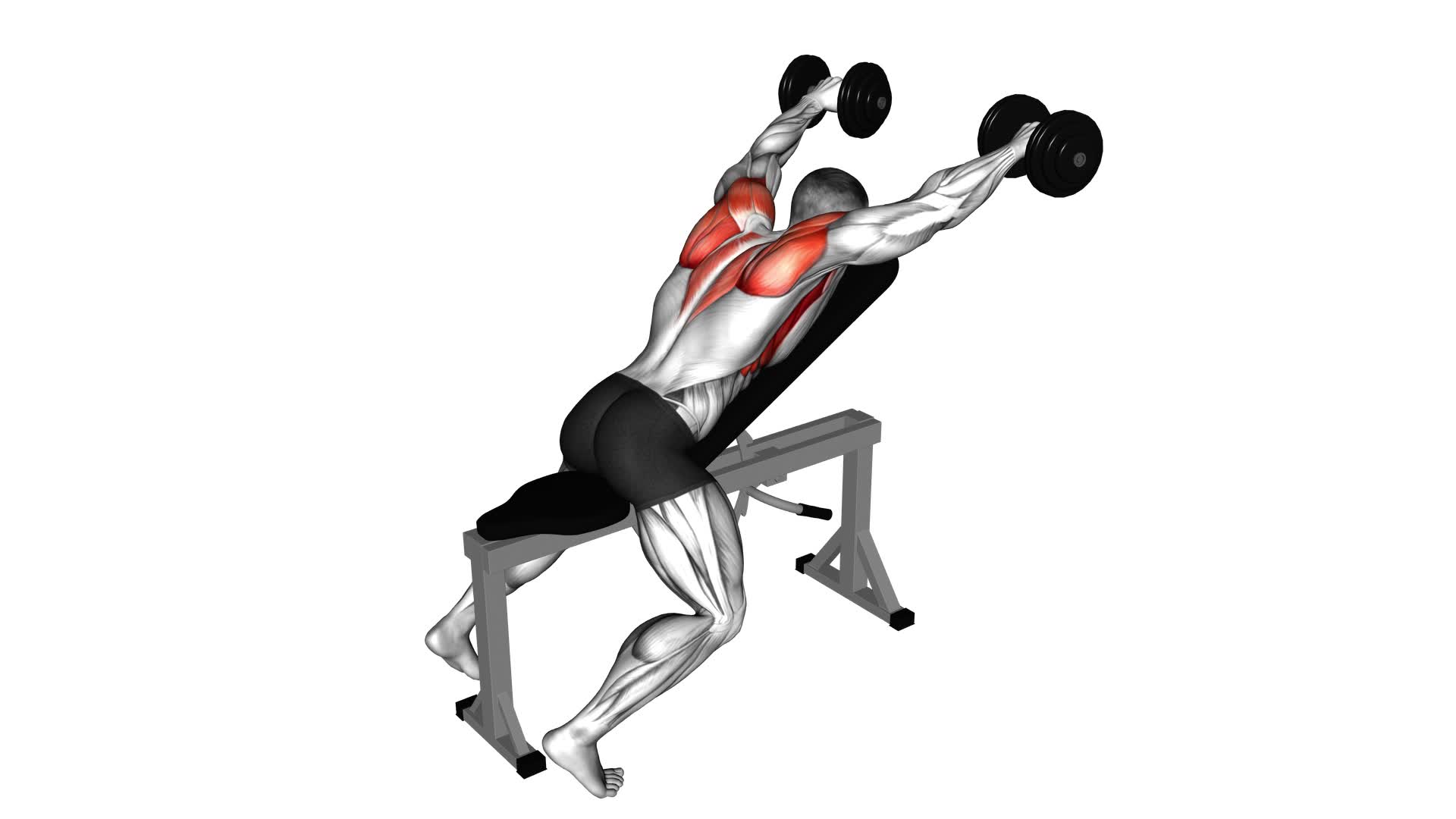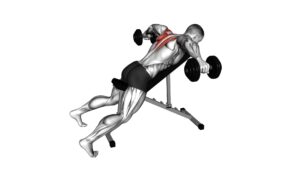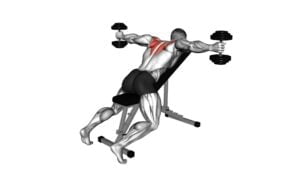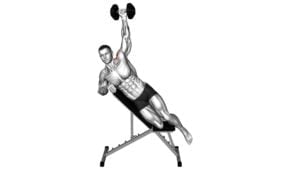Dumbbell Incline Y Raise – Video Exercise Guide & Tips

Looking to strengthen and tone your upper body? The dumbbell incline Y raise is a great exercise for targeting your shoulders and upper back.
Watch This Exercise Video
In this video exercise guide, we'll show you proper form and technique to maximize your results. Avoid common mistakes and discover tips to increase the intensity of this exercise.
Whether you're a beginner or advanced, we'll also provide modifications and alternatives to suit your fitness level.
Get ready to elevate your workout with the dumbbell incline Y raise!
Key Takeaways
- Dumbbell Incline Y Raise is highly effective for targeting and strengthening shoulder muscles, including the neglected posterior deltoids.
- Proper form and technique are crucial, focusing on shoulder alignment, a full range of motion, and engaging shoulder muscles while avoiding shrugging or tensing the neck and shoulders.
- Choosing the right equipment, such as a bench set at a 45-degree angle and suitable dumbbells, ensures safety and effectiveness.
- Intensity techniques and modifications, such as increasing weight, incorporating supersets or drop sets, and adjusting incline or range of motion, can be used to challenge shoulder muscles and accommodate different fitness levels.
Benefits of the Dumbbell Incline Y Raise
You will experience numerous benefits from incorporating the Dumbbell Incline Y Raise into your workout routine. This shoulder exercise is highly effective for targeting and strengthening the muscles in your shoulders. By performing the Dumbbell Incline Y Raise, you won't only improve your shoulder strength, but also enhance your overall posture and stability.
One of the key benefits of this exercise is that it engages the muscles in your shoulders in a unique way. The incline position allows for a greater range of motion, activating different muscle fibers and leading to more comprehensive shoulder development. Additionally, the Y shape of the movement targets the posterior deltoids, which are often neglected in traditional shoulder exercises.
Another advantage of the Dumbbell Incline Y Raise is its versatility. There are various variations of this exercise that you can incorporate into your shoulder workout routine. You can adjust the incline angle to target different areas of your shoulders, such as the front or the sides. Additionally, you can use different weights to increase or decrease the intensity of the exercise, catering to your individual fitness level.
Incorporating the Dumbbell Incline Y Raise into your routine won't only improve your shoulder strength, but also enhance your overall physique.
Now let's move on to the equipment needed for this exercise.
Equipment Needed for the Exercise
To perform the dumbbell incline Y raise, you'll need some essential equipment.
First and foremost, you'll need a bench set at a 45-degree angle to provide proper support and stability.
Additionally, you'll need a pair of dumbbells that are suitable for your fitness level.
It's important to choose the right equipment to ensure safety and maximize the effectiveness of this exercise.
Essential Equipment for Exercise
To perform the Dumbbell Incline Y Raise exercise, you'll need a set of dumbbells. Dumbbells are a versatile and essential piece of equipment for a variety of exercises. When it comes to equipment maintenance, it's important to keep your dumbbells clean and free of any rust or damage. Regularly inspecting them for wear and tear is also crucial to ensure their longevity.
If you're looking for cost-effective options, there are plenty of affordable dumbbell sets available in the market. You can also consider purchasing second-hand dumbbells or using adjustable dumbbells that allow you to change the weight as needed. Proper equipment for safety is vital in any exercise routine, and having the right set of dumbbells will contribute to a safe and effective workout.
Proper Equipment for Safety
To ensure a safe and effective workout, it's crucial to have the proper equipment for the Dumbbell Incline Y Raise exercise.
Equipment safety is of utmost importance to prevent injuries and maximize the benefits of this exercise.
First and foremost, you'll need a sturdy incline bench that can be adjusted to various angles. This will provide stability and support for your body throughout the movement.
Additionally, you'll need a pair of dumbbells with an appropriate weight for your fitness level. The dumbbells should be comfortable to hold and have a secure grip to prevent any accidents.
It's also recommended to have a spotter or trainer present to assist and guide you during the exercise.
Equipment Options for Variations
For variations of the Dumbbell Incline Y Raise exercise, you'll need different equipment options.
These options allow you to target specific muscle groups and add variety to your workout routine.
One equipment option is using resistance bands instead of dumbbells.
Resistance bands provide a different type of resistance and can help increase the difficulty of the exercise.
Another equipment option is using a stability ball instead of an incline bench.
This adds an element of instability, engaging more core muscles and challenging your balance.
Additionally, you can incorporate a cable machine or a TRX suspension trainer for more advanced variations of the Dumbbell Incline Y Raise.
These equipment options provide endless possibilities for exercise variations, allowing you to continuously challenge and improve your strength and stability.
Proper Form and Technique for the Dumbbell Incline Y Raise
To perform the dumbbell incline Y raise with proper form and technique, it's important to focus on shoulder alignment and optimizing the range of motion.
Keep your shoulders back and down throughout the movement to maintain proper alignment and engage the targeted muscles effectively.
Additionally, aim to achieve a full range of motion by lifting the dumbbells up towards your ears while keeping your arms straight.
Shoulder Alignment During Y Raise
Maintain proper shoulder alignment during the Dumbbell Incline Y Raise by keeping your shoulders relaxed and away from your ears. Shoulder stability is crucial in this exercise to prevent injury and maximize effectiveness.
As you lift the dumbbells in a Y shape, focus on engaging your shoulder muscles while keeping your shoulders down and back. Avoid shrugging or tensing your neck and shoulders, as this can lead to strain and discomfort.
By maintaining proper shoulder alignment, you ensure that the targeted muscles are being properly activated and that the exercise is performed safely.
As you progress in your workout routine, you can increase the weight of the dumbbells or adjust the incline to challenge your shoulder muscles further. Remember, proper form and technique are key to getting the most out of the Dumbbell Incline Y Raise.
Range of Motion Optimization
As you perform the Dumbbell Incline Y Raise, focus on optimizing your range of motion for proper form and technique. Range of motion refers to the full movement potential of a joint or muscle group.
To improve your range of motion during the Dumbbell Incline Y Raise, it's essential to incorporate stretching techniques into your workout routine. Stretching exercises that target the shoulders, such as shoulder circles and arm swings, can help improve flexibility and increase the range of motion in the shoulder joint.
Additionally, it's crucial to warm up properly before performing the exercise. A proper warm-up can increase blood flow to the muscles, improve joint lubrication, and prepare the body for the demands of the exercise, ultimately improving range of motion.
Common Mistakes to Avoid During the Exercise
Avoid lifting too heavy of dumbbells during the Dumbbell Incline Y Raise exercise. One of the common mistakes people make is using weights that are too heavy for them, compromising their form and risking injury. It's important to remember that proper technique should always take precedence over the amount of weight lifted.
Another mistake to avoid isn't maintaining a controlled movement throughout the exercise. Some individuals tend to use momentum to swing the dumbbells up, rather than relying on their shoulder muscles to perform the movement. This not only reduces the effectiveness of the exercise, but it also increases the risk of straining or injuring the shoulder joints.
Additionally, it's crucial to maintain a stable and supported position on the incline bench. Failing to do so can lead to improper alignment of the spine and shoulders, which can cause discomfort and potentially lead to injury. Make sure to adjust the bench to a suitable angle and firmly plant your feet on the ground for stability.
Lastly, avoid shrugging your shoulders or tensing your neck during the exercise. This can create unnecessary tension in the upper body and detract from the targeted muscles. Focus on keeping your shoulders relaxed and your neck in a neutral position throughout the movement.
Tips to Increase the Intensity of the Dumbbell Incline Y Raise
To increase the intensity of the Dumbbell Incline Y Raise, incorporate heavier dumbbells into your workout routine. By challenging yourself with heavier weights, you can effectively increase the difficulty of this exercise and continue to make progress.
Here are some tips to help you increase the intensity of the Dumbbell Incline Y Raise:
- Gradually increase the weight: Start by adding a small amount of weight to your dumbbells and gradually increase it over time. This will allow your muscles to adapt and grow stronger.
- Focus on form and control: Maintaining proper form is essential for maximizing the effectiveness of this exercise. Slowly lift the dumbbells while keeping your arms straight and your back flat against the bench.
- Increase the number of repetitions: Once you're comfortable with the exercise, try increasing the number of repetitions you perform. This will further challenge your muscles and promote muscle growth.
- Decrease rest time: To increase the intensity, decrease the amount of rest time between sets. This will keep your muscles engaged and make the exercise more challenging.
- Incorporate supersets or drop sets: To further challenge yourself, you can incorporate supersets or drop sets into your workout routine. This involves performing another exercise immediately after completing a set of Dumbbell Incline Y Raises, without resting in between.
By implementing these tips, you can effectively increase the difficulty of the Dumbbell Incline Y Raise and continue to progress in your fitness journey.
Now, let's explore some modifications and alternatives for different fitness levels.
Modifications and Alternatives for Different Fitness Levels
To modify or find alternatives for the Dumbbell Incline Y Raise based on different fitness levels, consider the following options.
Modification options:
- Decrease the weight: If you find the dumbbell too heavy, start with a lighter weight until you build enough strength to progress. Gradually increase the weight as you become more comfortable with the exercise.
- Adjust the incline: If the incline bench is too challenging, try a lower incline or even a flat bench. This will decrease the resistance and make the exercise easier to perform.
- Reduce the range of motion: If you struggle to lift the dumbbells all the way up into a Y shape, limit the range of motion and focus on lifting the dumbbells to shoulder height. This will still target your shoulder muscles effectively while making the exercise more manageable.
Alternative exercises:
- Bent-over lateral raises: Stand with your feet shoulder-width apart, bend your knees slightly, and lean forward at the waist. Hold the dumbbells in front of you with your palms facing each other. Lift the dumbbells out to the sides until they're parallel to the floor, then lower them back down.
- Cable lateral raises: Attach a D-handle to a cable machine at hip height. Stand sideways to the machine, grab the handle with one hand, and lift it out to the side while keeping your arm straight. Lower the handle back down and repeat on the other side.
These modification options and alternative exercises can help you adjust the Dumbbell Incline Y Raise to your fitness level and ensure a safe and effective workout. Remember to always listen to your body and choose the option that feels challenging but manageable for you.
Frequently Asked Questions
How Many Sets and Repetitions Should I Do for the Dumbbell Incline Y Raise?
To get the most out of your dumbbell incline Y raises, it's important to consider the number of sets and repetitions. Finding the right balance is key.
Start with 2-3 sets of 10-12 reps to build strength and improve shoulder stability.
As you progress, you can increase the sets and reps to challenge yourself further.
Can I Use Resistance Bands Instead of Dumbbells for the Exercise?
Yes, you can definitely use resistance bands instead of dumbbells for the dumbbell incline Y raise exercise.
Resistance bands provide a different type of resistance compared to dumbbells, which can help enhance muscle activation and promote stability.
Additionally, using resistance bands can offer a wider range of motion and target different muscle groups.
Incorporating resistance bands into your workout routine can add variety and challenge to your exercises, ultimately leading to improved strength and muscle development.
Is It Necessary to Have an Incline Bench for the Dumbbell Incline Y Raise?
No, it isn't necessary to have an incline bench for the dumbbell incline Y raise. The incline bench is typically used to increase the range of motion and target the upper back muscles more effectively.
However, you can still benefit from the exercise without an incline bench. To target different muscles, you can try variations such as the seated Y raise or the standing Y raise. These variations can help engage your shoulders and upper back muscles.
How Long Should I Rest Between Sets?
To optimize your workout, it's important to consider how long you should rest between sets.
Rest periods for the dumbbell incline Y raise can vary depending on your fitness level and goals.
Typically, a rest period of 30-60 seconds is sufficient for building strength and muscle endurance.
However, if you're aiming for maximum muscle hypertrophy, longer rest periods of 2-3 minutes may be more beneficial.
Experiment with different rest times to find what works best for you and your fitness goals.
Can I Incorporate the Dumbbell Incline Y Raise Into a Full-Body Workout Routine?
Incorporating the dumbbell incline Y raise into your full-body workout routine can provide numerous benefits. This exercise targets your shoulders, upper back, and rear delts, helping to improve overall posture and upper body strength. It also engages your core for stability.
To target different muscle groups, you can try variations such as the dumbbell incline T raise or the dumbbell incline W raise.
Conclusion
In conclusion, the dumbbell incline Y raise is an effective exercise for targeting the upper back and shoulder muscles. By maintaining proper form and technique, you can maximize the benefits of this exercise while avoiding common mistakes.
To increase the intensity, you can adjust the weight or perform the exercise at a slower pace. Additionally, modifications and alternatives are available for individuals of different fitness levels.
Incorporating the dumbbell incline Y raise into your workout routine can help improve strength and posture.

Author
Years ago, the spark of my life’s passion ignited in my mind the moment I stepped into the local gym for the first time. The inaugural bead of perspiration, the initial endeavor, the very first surge of endorphins, and a sense of pride that washed over me post-workout marked the beginning of my deep-seated interest in strength sports, fitness, and sports nutrition. This very curiosity blossomed rapidly into a profound fascination, propelling me to earn a Master’s degree in Physical Education from the Academy of Physical Education in Krakow, followed by a Sports Manager diploma from the Jagiellonian University. My journey of growth led me to gain more specialized qualifications, such as being a certified personal trainer with a focus on sports dietetics, a lifeguard, and an instructor for wellness and corrective gymnastics. Theoretical knowledge paired seamlessly with practical experience, reinforcing my belief that the transformation of individuals under my guidance was also a reflection of my personal growth. This belief holds true even today. Each day, I strive to push the boundaries and explore new realms. These realms gently elevate me to greater heights. The unique combination of passion for my field and the continuous quest for growth fuels my drive to break new ground.







